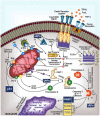Regulation of Apoptosis by Gram-Positive Bacteria: Mechanistic Diversity and Consequences for Immunity
- PMID: 19081777
- PMCID: PMC2600511
- DOI: 10.2174/157339506776843033
Regulation of Apoptosis by Gram-Positive Bacteria: Mechanistic Diversity and Consequences for Immunity
Abstract
Apoptosis, or programmed cell death (PCD), is an important physiological mechanism, through which the human immune system regulates homeostasis and responds to diverse forms of cellular damage. PCD may also be involved in immune counteraction to microbial infection. Over the past decade, the amount of research on bacteria-induced PCD has grown tremendously, and the implications of this mechanism on immunity are being elucidated. Some pathogenic bacteria actively trigger the suicide response in critical lineages of leukocytes that orchestrate both the innate and adaptive immune responses; other bacteria proactively prevent PCD to benefit their own survival and persistence. Currently, the microbial virulence factors, which represent the keys to unlocking the suicide response in host cells, are a primary focus of this field. In this review, we discuss these bacterial "apoptosis regulatory molecules" and the apoptotic events they either trigger or prevent, the host target cells of this regulatory activity, and the possible ramifications for immunity to infection. Gram-positive pathogens including Staphylococcus, Streptococcus, Bacillus, Listeria, and Clostridia species are discussed as important agents of human infection that modulate PCD pathways in eukaryotic cells.
Figures


Similar articles
-
Programmed cell death in tumor immunity: mechanistic insights and clinical implications.Front Immunol. 2024 Jan 12;14:1309635. doi: 10.3389/fimmu.2023.1309635. eCollection 2023. Front Immunol. 2024. PMID: 38283351 Free PMC article. Review.
-
The Influence of Programmed Cell Death in Myeloid Cells on Host Resilience to Infection with Legionella pneumophila or Streptococcus pyogenes.PLoS Pathog. 2016 Dec 14;12(12):e1006032. doi: 10.1371/journal.ppat.1006032. eCollection 2016 Dec. PLoS Pathog. 2016. PMID: 27973535 Free PMC article.
-
Evaluation of Caspase Activation to Assess Innate Immune Cell Death.J Vis Exp. 2023 Jan 20;(191):10.3791/64308. doi: 10.3791/64308. J Vis Exp. 2023. PMID: 36744800 Free PMC article.
-
Reprogramming of Cell Death Pathways by Bacterial Effectors as a Widespread Virulence Strategy.Infect Immun. 2022 May 19;90(5):e0061421. doi: 10.1128/iai.00614-21. Epub 2022 Apr 25. Infect Immun. 2022. PMID: 35467397 Free PMC article. Review.
-
Programmed necrosis in microbial pathogenesis.Trends Microbiol. 2014 Apr;22(4):199-207. doi: 10.1016/j.tim.2014.01.005. Epub 2014 Feb 21. Trends Microbiol. 2014. PMID: 24565922 Review.
Cited by
-
Infection-induced IL-10 and JAK-STAT: A review of the molecular circuitry controlling immune hyperactivity in response to pathogenic microbes.JAKSTAT. 2012 Jul 1;1(3):159-67. doi: 10.4161/jkst.19918. JAKSTAT. 2012. PMID: 24058765 Free PMC article. Review.
-
Streptococcus adherence and colonization.Microbiol Mol Biol Rev. 2009 Sep;73(3):407-50, Table of Contents. doi: 10.1128/MMBR.00014-09. Microbiol Mol Biol Rev. 2009. PMID: 19721085 Free PMC article. Review.
-
Crystal Structures of Group B Streptococcus Glyceraldehyde-3-Phosphate Dehydrogenase: Apo-Form, Binary and Ternary Complexes.PLoS One. 2016 Nov 22;11(11):e0165917. doi: 10.1371/journal.pone.0165917. eCollection 2016. PLoS One. 2016. PMID: 27875551 Free PMC article.
-
The early phase transcriptome of bovine monocyte-derived macrophages infected with Staphylococcus aureus in vitro.BMC Genomics. 2013 Dec 17;14:891. doi: 10.1186/1471-2164-14-891. BMC Genomics. 2013. PMID: 24341851 Free PMC article.
-
Induction of Central Host Signaling Kinases during Pneumococcal Infection of Human THP-1 Cells.Front Cell Infect Microbiol. 2016 Apr 26;6:48. doi: 10.3389/fcimb.2016.00048. eCollection 2016. Front Cell Infect Microbiol. 2016. PMID: 27200303 Free PMC article.
References
-
- Chen Y, Zychlinsky A. Apoptosis induced by bacterial pathogens. Microb Pathog. 1994;17(4):203–12. - PubMed
-
- Weinrauch Y, Zychlinsky A. The induction of apoptosis by bacterial pathogens. Annu Rev Microbiol. 1999;53:155–87. - PubMed
-
- Behnia M, Robertson KA, Martin WJ., 2nd Lung infections: role of apoptosis in host defense and pathogenesis of disease. Chest. 2000;117(6):1771–7. - PubMed
-
- Navarre WW, Zychlinsky A. Pathogen-induced apoptosis of macrophages: a common end for different pathogenic strategies. Cell Microbiol. 2000;2(4):265–73. - PubMed
-
- Dockrell DH. Apoptotic cell death in the pathogenesis of infectious diseases. J Infect. 2001;42(4):227–34. - PubMed
Grants and funding
LinkOut - more resources
Full Text Sources
Other Literature Sources
Miscellaneous
